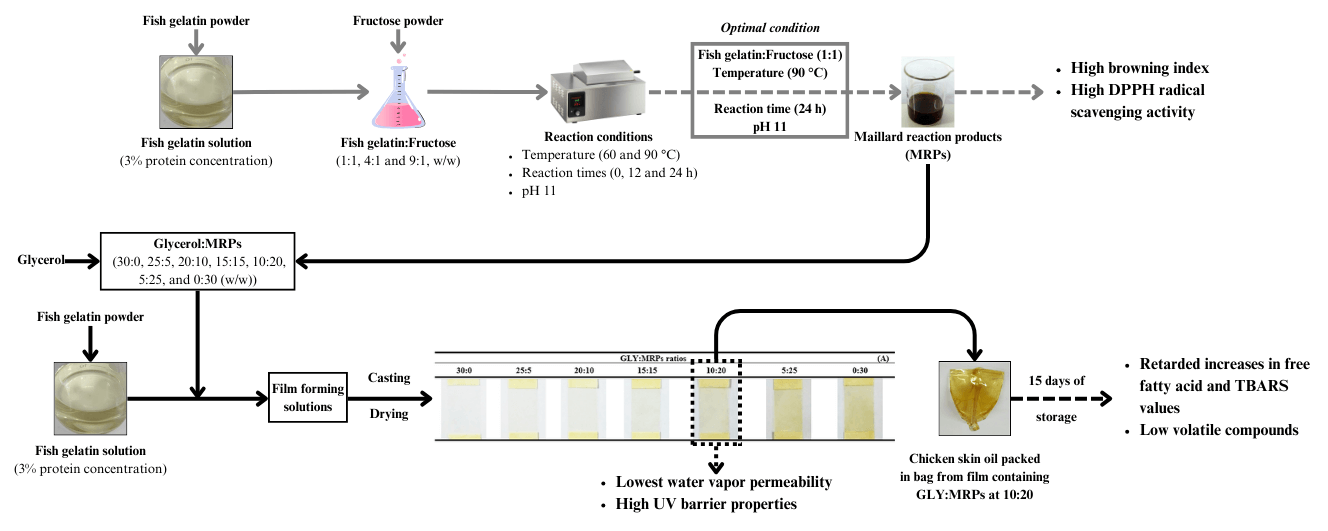 Open Access
Open Access
ARTICLE
Fish Gelatin-Based Film Containing Maillard Reaction Products: Properties and Its Use as Bag for Packing Chicken Skin Oil
1 International Center of Excellence in Seafood Science and Innovation, Faculty of Agro-Industry, Prince of Songkla University, Songkhla, 90110, Thailand
2 Department of Food Safety and Quality Management, Poznań University of Life Sciences, Poznań, 60-637, Poland
3 Center of Excellence in Bio-Based Materials and Packaging Innovation, Faculty of Agro-Industry, Prince of Songkla University, Hat Yai, Songkhla, 90110, Thailand
4 Department of Food and Nutrition, Kyung Hee University, Seoul, 02447, Republic of Korea
* Corresponding Authors: Krisana Nilsuwan. Email: ; Soottawat Benjakul. Email:
Journal of Renewable Materials 2024, 12(6), 1125-1143. https://doi.org/10.32604/jrm.2024.051361
Received 03 March 2024; Accepted 29 May 2024; Issue published 02 August 2024
Abstract
Maillard reaction is a non-enzymatic browning reaction and its products (MRPs) have been proven to possess antioxidant properties. This research aimed to produce a fish gelatin-based packaging incorporated with MRPs to retard lipid oxidation in chicken skin oil (CSO) during storage at ambient temperature (28°C–30°C). MRPs produced from fish gelatin and fructose (1:1, 90°C, pH 11) showed the highest antioxidant properties compared to those prepared under other conditions. Different glycerol/MRPs ratios (30:0, 25:5, 20:10, 15:15, 10:20, 5:25, 0:30) were incorporated into the film and resulting films were characterized. Glycerol/MRPs at 10:20 ratio was chosen to add into the film prior to bag preparation via heat sealing method. CSO packed in the bag was monitored for lipid hydrolysis and oxidation during 15 days of storage (30°C ± 0.5°C, RH 52% ± 5%). After 15 days, quality deterioration was lower in CSO packed in the prepared gelatin bag as evidenced by lower FFA, TBARS, and volatile compounds in comparison with CSO packed in LDPE bag. Fish gelatin film added with MRPs possessed an excellent water vapor barrier property (WV-BP). This finding indicated that MRPs could be used to substitute glycerol and simultaneously could serve as antioxidants for the developed active bag. The novel packaging can be a potential alternative packaging for retarding lipid oxidation of lipid or fatty foods.Graphic Abstract

Keywords
Cite This Article
 Copyright © 2024 The Author(s). Published by Tech Science Press.
Copyright © 2024 The Author(s). Published by Tech Science Press.This work is licensed under a Creative Commons Attribution 4.0 International License , which permits unrestricted use, distribution, and reproduction in any medium, provided the original work is properly cited.


 Submit a Paper
Submit a Paper Propose a Special lssue
Propose a Special lssue View Full Text
View Full Text Download PDF
Download PDF Downloads
Downloads
 Citation Tools
Citation Tools